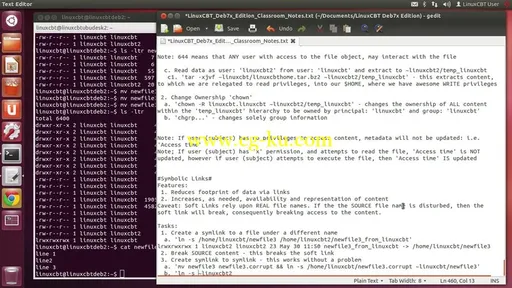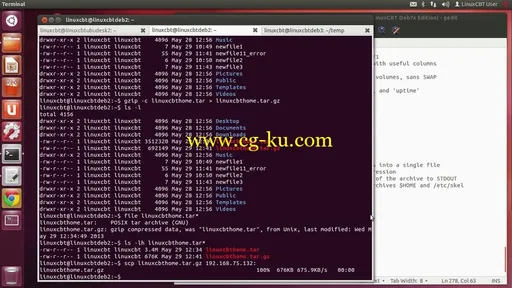
LinuxCBT Deb7x Edition
English | mp4 | H264 1356x766 | AAC 1 ch | 40 hrs 4 min | 6.93 GB
Course Objective
Features Discussion and Various Installations
- Enumerate relevant features
- Discuss platform support
- Installation preparation
- Obtain relevant ISO image
- Prepare VMWare environment to support Debian
- Install and evaluate
- Update network configuration
- Prepare environment for rapid implementation
- Clone instance and modify accordingly
- Evaluate cloned resource as needed
- Prepare Debian for Xen VM installation
- Provision resources for Xen
- Install on Xen as HVM and evaluate
Basic Debian GNU/Linux Skills
Explore usage of the following useful commands
- ls, pwd, cd, cp, mv, rm, mkdir, rmdir, whoami, tty
- cat, file, chmod, chown, history
- STDIN, STDOUT, STDERR, UNIX Pipes, Redirection, Command Chaining
- ps, df, free, top, kill
- less & more, head & tail, find
- stat, which, w, who
- dig (Domain Information Groper) - used to query DNS servers
- Tar and compression utilities with tar|gzip|bzip2
- Use checksum programs to confirm content integrity
- Explain UNIX/Linux file security & permissions
- Symlinks | Hard Links | Soft Links | Special Bits
Storage Management
- Explore disk topology with FDISK
- Provision EXT4 File Systems as needed
- Provision additional Storage partitions using Parted
- Provision additional Swap storage
- Use MKSWAP & SWAPON to enable additional Swap storage
- Update File System Table (FSTAB) to reflect system changes
- Explore Logical Volume Management (LVM) Configuration
- Create volume sets using: Logical Volume Management (LVM)
Package Management
- Explain classes of Debian GNU/Linux Packages
- Identify Debian GNU/Linux Package Management Tools
- Inventory currently installed DEB packages
- Identify key Advanced Package Tool (APT) configuration files
- Search for Debian GNU/Linux packages using Advanced Package Tool (APT)
- Install/Update/Remove software using APT
- Configure APT to query multiple sources for packages
- Peruse package repository using 'dpkg'
- Configure APT to install packages from varying versions of Debian GNU/Linux
- Use Aptitude to manage Debian GNU/Linux packages
- Discuss various package management options
- Explore package management repositories
- Use DPKG to install a .deb package
- Install packages using 'apt-get'
- Manage packages using 'aptitude'

System Control
- Peruse key directories used by Kernel
- Discuss hierarchy as applied to functioning system
- Identify supported settings
- Influence settings real time and evaluate
- Committ settings for persistence
- Confirm persistence of directives
- Discuss various possible system tweaks
Screen TTYs | PTYs
- Discuss TTY | PTY limitations
- Identify opportunites to benefit from Screen
- Identify configuration environment
- Invoke and use screen natively
- Confirm persistence of TTYs | PTYs across sessions
- Share Screen sessions
- Confirm overall efficacy of Screen
Explore the CRON scheduling daemon & configuration
- Identify key Cron configuration scopes (Global & User)
- Explain Crontab file format and applicable options
- Define global cron jobs
- Define custom cron jobs user-wide
- Evaluate results of cron jobs
Core Network Services
- System Logging via RSyslog and Logrotate
-- Discuss Syslog Facilities | Levels
-- Explore default configuration
-- Receive Syslog data via network
-- Mirror Syslog log as needed
-- Trap Infrastructure device logs and evaluate
-- Explore log rotation and customization via Logrotate
-- Discuss key log rotation use cases
-- Configure Logrotate to rotate sample log files
-- Evaluate results
- Common Network Utilities
-- PING
-- TELNET
-- NETSTAT
-- ARP
-- TRACEPATH
-- DIG
- Interface Configuration
-- Explore network configuration tree
-- Alter settings and evaluate
-- Provision aliased interfaces as needed
-- Confirm communications via various interfaces
-- Committ configuration for persistence
-- Provision interface configuration on various nodes
-- Evaluate accordingly
- RSYNC Transmissions
-- Discuss features and benefits
-- Generate and move data between nodes as needed
-- Confirm results
-- Explore various rsync options
-- Synchronize content as needed
-- Evaluate rsync applicability
- Network Time Protocol Configuration
-- Discuss applicability
-- Install and explore default configuration
-- Re-configure environment to suit internal requirements
-- Confirm ntp strata assignments
-- Ensure time synchronization across nodes
- Very Secure File Transfer Protocol Daemon (VSFTPD)
-- Explain features and applicability
-- Peruse default configuration
-- Test anonymous FTP connectivity
-- Secure configuration per general requirements
-- Use various FTP clients to communicate with VSFTPD
-- Enable local user access
-- Jail users to $HOME - added security
-- Evaluate results
- BIND Domain Name Server - DNS Implementation
-- Implement BIND 9x
-- Configure BIND as a caching-only DNS server
-- Test caching-only name resolution from various nodes
-- Configure primary DNS services
-- Replicate primary content to secondary DNS node
-- Confirm replication information
-- Disable primary and evaluate secondary behaviour
-- Vary TTLs of records and evaluate responsiveness
-- Configure reverse DNS zone - IPv4
-- Provision forward and reverse IPv6 records
-- Confirm IPv[4|6] record resolution
- Windows Integration via Samba
-- Explore default Samba footprint
-- Use Samba clients to ascertain NETBIOS (SMB|CIFS) information
-- Install Samba Server
-- Configure User-level security and evaluate access
-- Provision bridge user and test access
-- Rationalize ineffectiveness of User-level security
-- Contrast User | ADS security levels
-- Install ADS support via Winbind and Kerberos
-- Install Samba SWAT for streamlined web-based administration
-- Connect Samba node to Active Directory Services (ADS)
-- Confirm enumeration of ADS resources
-- Test connectivity via: NETBIOS and SSH
-- Evaluate results
- Apache HTTPD - Web Services
-- Implement Apache Web Server
-- Explore configuration hierarchy
-- Discuss key directives
-- Peruse Apache logging templates and defaults
-- Vary logged information as needed
-- Provision IP-Based Virtual Hosts (VHosts)
-- Confirm distinct IP-Based connectivity to various sites
-- Contrast IP-Based sites with default sites
-- Conserve IP resources with Name-Based VHosts
-- Contrast various VHost types
-- Secure communications with Apache SSL | TLS
-- Test connectivity to various SSL|TLS-enabled sites
- MySQL Installation | Administration
-- Install MySQL Relational Database Management System
-- Explore default client | server environment
-- Use Terminal Monitor Client to ascertain DBMS details
-- Secure DBMS - Remove superfluous accounts
-- Create simple MySQL database with 'mysql' and 'ssh'
-- Install PHPMyAdmin for web-based management of MySQL
-- Use PHPMyAdmin to ascertain DBMS details
-- Test connectivity as various users
-- Explore PHPMyAdmin's interface
-- Evaluate accordingly
- PHP Intro | CLI Script
-- Explore default implementation
-- Ensure proper PHP stack is installed
-- Expose useful debug variables - Apache | PHP
-- Write simple data copy CLI script - normalize file delimiters
-- Evaluate results
- Postfix MTA
-- Install Postfix MTA
-- Introduction to Postfix Message Transfer Agent (MTA)
-- Use Mutt to demonstrate outbound mail handling using Postfix
-- Explore Postfix Configuration
- Post Office Protocol Version 3 (POP3)
-- Explain POP3 concepts and applications
-- Implement POP3 daemon
-- Test basic $SHELL-based connectivity
-- Use Mutt to send SMTP-based messages to POP3 account
-- Configure MUA to interact with POP3 server
-- Contrast clear-text and encrypted communications
- Internet Messaging Access Protocol (IMAP)
-- Contrast IMAP with POP3
-- Install IMAP server
-- Fetch mail from IMAP server and evaluate
-- Confirm secure communications
- Web-based Mail Implementation using Squirrel-mail
-- Describe required squirrel mail components for web-mail integration
-- Install squirrel mail on Debian GNU/Linux system
-- Configure Apache virtual directory for squirrel mail integration
-- Configure Apache Virtual Host for squirrel mail integration
-- Configure BIND DNS services for squirrel mail integration
-- Explore squirrel mail's web-based interface
- Improve Security Posture
-- Update and Upgrade install Packages
-- Identify changes across Nodes
-- Secure content with GNU Privacy Guard (GPG)
-- Explore benefits of various Secure Shell clients
-- Peruse Secure Shell Server security
-- Disable superfluous services
-- Explore and tighten System Policy
-- Login Definitions
-- Evaluate Results
- NMap Security Scanner
-- Obtain, compile and install current version of NMAP
-- Identify commonly used NMAP options/switches/parameters
-- Perform default TCP SYN-based ethical scans of local and remote resources
-- Explain typical TCP handshake protocol while using NMAP
-- Perform default TCP Connect-based ethical scans of local and remote resources
-- Peform local ethical scans
-- Identifiy key NMAP configuration files
-- Use NMAP to perform operating system fingerprinting and versioning
-- Peform subnet-wide ethical scans
- TCPDump Introduction | Usage
-- Identify key tools
-- Use TCPDump to capture traffic
-- Apply Berkeley Packet Filters accordingly
-- Capture and analyze traffic with Wireshark
-- Evaluate Results
- IPTABLES (Netfilter Linux Kernel-based Firewall)
-- Discuss features and benefits
-- Explore IPTABLES default chains/filters and policies
-- Filter traffic as desired
-- Log filtered traffic and evaluate
-- Filter traffic based on Layer-4 TCP/UDP (Source/Destination Ports) information
-- Summarize rules with filtered groups of interesting traffic
-- Restrict access to various daemons (SSH/FTP/HTTP/etc.)
-- Test connectivity locally and remotely
-- Ensure rules persistence across restarts
- Secure Key Services
-- Identify remaining services
-- Generate SSL | TLS Usage Keys
-- Configure FTP Server with SSL | TLS
-- Test secure communications with LFTP and FileZilla
-- MySQL with Secure Shell Security
-- MySQL with SSL | TLS Security
-- Evaluate Results
- Snort® NIDS Introduciton | Usage
-- Discuss features and benefits
-- Explore online sources
-- Install Snort Network Intrusion Detection System Packages
-- Use Snort to intercept interesting traffic as Sniffer
-- Log for archival purposes
-- Apply BPFs as needed
-- Parse captured traffic with common tools
-- Explore NIDS configuration mode
-- Evaluate results